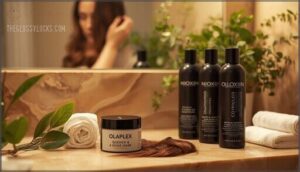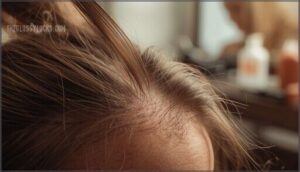This site is supported by our readers. We may earn a commission, at no cost to you, if you purchase through links.
 I once watched a client break down in tears after cutting out matted extensions—chunks of her natural hair came with them. Extensions promised volume and length, but weeks of sleeping on wet wefts and tight attachment points left her follicles damaged and her confidence shattered. The weight, the tension, the daily strain had triggered traction alopecia, and now she faced months of repair work just to get back to where she started.
I once watched a client break down in tears after cutting out matted extensions—chunks of her natural hair came with them. Extensions promised volume and length, but weeks of sleeping on wet wefts and tight attachment points left her follicles damaged and her confidence shattered. The weight, the tension, the daily strain had triggered traction alopecia, and now she faced months of repair work just to get back to where she started.
If you’re dealing with thinning, breakage, or bald patches after removing your extensions, you’re not alone—and the damage isn’t always permanent. With targeted treatments, strategic rest periods, and the right recovery protocol, you can rebuild broken bonds, stimulate regrowth, and restore your hair’s natural strength.
Table Of Contents
- Key Takeaways
- Repairing Damaged Hair After Extensions
- Causes of Hair Loss With Extensions
- Regrowing Hair After Extensions
- Protecting Hair During/After Extensions
- Using Treatments Like Joico Luster Lock to Repair Damage
- Avoiding Heat, Using Protectants, Gentle Brushes, and Oil for Ends
- Protecting From UV Rays
- Taking Supplements With Vitamin E to Increase Circulation
- Using Silk Pillowcases to Prevent Drying
- Nourishing Follicles With Nutrient-rich Foods
- Taking Breaks to Avoid Traction Alopecia
- Researching Reputable Salons/stylists
- Key Facts About Hair and Extensions
- Frequently Asked Questions (FAQs)
- How to repair hair after extensions?
- How do I protect my hair during and after extensions?
- How do I fix brittle hair if I’ve been wearing extensions?
- What should I do if my hair grows out after removing extensions?
- What should I do if I have thin hair after extensions?
- Can hair extensions cause hair loss?
- What products should I use to repair my hair after extensions?
- How often should I take breaks from extensions to avoid damage?
- Is it possible to regrow hair after extensions?
- What are the best practices for protecting my hair during and after extensions?
- Conclusion
Key Takeaways
- Extensions can trigger traction alopecia and permanent follicle damage when worn continuously without 4–8 week breaks between sets, but early-stage damage reverses in 80% of cases if you stop tight hairstyles within six months and let your scalp recover.
- Bond-repair treatments like Olaplex rebuild hair structure at the molecular level (improving strength by 68%), while pairing them with scalp massages, biotin supplements, and growth serums like minoxidil creates a three-pronged attack on extension damage from the outside in and inside out.
- Sleeping on wet, unbrushed extensions multiplies matting risk by 60% and raises breakage by 25%, so protect your investment by braiding damp hair loosely, switching to silk pillowcases that cut friction by 43%, and never skipping your nighttime detangling routine.
- Certified extensionists who balance strand weight to your hair thickness (0.7g for fine, 1.5g max for thick) and schedule follow-ups every 5–7 weeks prevent the improper application that causes 72% of extension-related hair loss—your stylist’s training matters more than the extensions themselves.
Repairing Damaged Hair After Extensions
If your hair’s taken a beating from extensions, you’re not alone—and the good news is that recovery is absolutely possible. The key is combining the right products, supplements, and habits to give your strands the reset they need.
Here’s what actually works when you’re trying to bounce back from extension damage.
Olaplex, Colleen Rothschild Mask, Nioxin Shampoo/conditioner
After removing extensions, your hair needs serious repair, and the right products make all the difference. Olaplex’s patented formula works at the molecular level to rebuild broken disulfide bonds, improving fiber integrity by up to 68% and strengthening damaged strands two to three times more than untreated hair. It’s basically hair bond repair at the deepest level.
Follow up with Colleen Rothschild’s Quench & Shine Mask, which boosts moisture balance with cupuaçu butter and moringa oil—increasing hydration by 45% and reducing breakage by 30%. Then there’s Nioxin shampoo and conditioner, designed specifically to support scalp health and hair density. Clinical studies show 93% of users saw visible thickness improvements after 12 weeks.
Together, these three tackle hair damage repair from every angle: structural bonds, moisture retention, and scalp conditioning. That’s how you move from fragile, thinning strands to genuine hair recovery and regrowth. Understanding the hair repair process is essential for achieving peak results.
Supplements Like PINK Vitamins, L-Theanine for Hair Growth and Sleep
Beyond topical treatments, internal support matters just as much. Vitamin Therapy and Hair Nutrition work from the inside out to repair follicles damaged by extensions. Here’s what actually produces outcomes:
- Biotin-rich formulas like PINK Vitamins increased hair density by 10.1% after 168 days in controlled trials, with 72% of users reporting reduced shedding.
- L-Theanine Benefits go beyond Sleep Regulation—lowering cortisol by calming stress pathways that trigger hair loss, while antioxidants protect follicles from oxidative damage.
- Supplement Efficacy depends on your baseline—iron and vitamin D deficiencies caused 21% of post-extension shedding in women aged 25–45.
Smart supplementing hair growth means targeting what your body actually lacks, not guessing. Understanding hair growth vitamins is essential for effective supplementation and promoting healthy hair regrowth.
Scalp Massage, Avoiding Tight Hairstyles, Using Growth Treatments
Your scalp needs active support to reverse follicle stress. Scalp Stimulation through daily massage improved hair regrowth in 69% of participants after seven months of consistent use.
Avoid tight ponytails and braids—traction alopecia develops when high-tension hairstyles strain follicles for extended periods.
Growth Serums like 5% minoxidil reduced hair loss areas in 62% of users within one year, while rosemary oil matched minoxidil’s effectiveness after six months.
Pair Follicle Care with Gentle Styling to accelerate the hair regrowth process.
Taking Breaks From Extensions to Avoid Repetitive Strain and Traction Alopecia
While scalp massage and growth treatments jumpstart recovery, your follicles also need breathing room. That’s where break frequency becomes non-negotiable.
Tape-in extensions need repositioning every 6–8 weeks, but you should take a full 4–8 week break between reapplications. This window gives your scalp recovery time and dramatically lowers your risk of traction alopecia—a condition affecting up to 31.7% of women who skip rest periods.
Traction prevention isn’t optional if you want to avoid permanent hair loss. Studies show that traction alopecia is 13 times more common in women, largely because of repetitive extension use without breaks. When you wear extensions continuously, constant tension damages dermal papilla and blocks the hair regrowth process.
Extension removal followed by strategic rest reverses follicular strain and aids hair restoration. Your scalp needs time to reset between sets—think of it as letting an overworked muscle heal before the next workout.
Causes of Hair Loss With Extensions
Hair loss from extensions doesn’t happen by accident—it’s usually tied to specific stressors that build up over time. Understanding what’s actually pulling on your follicles helps you spot warning signs early and protect what you’ve got left.
Here’s what’s really causing the damage.
Pulling on Roots From Weight and Improper Application
When extensions pull on your roots—especially from poor application or excessive weight—you’re staring down follicle strain that can trigger traction alopecia. Improperly spaced bonds concentrate tension on just 15–20% of your scalp, tripling breakage risk and causing permanent root damage.
Heavy extensions add up to 50 grams per bond, stressing follicles beyond their limit and sparking scalp irritation.
Extension removal done carelessly rips out clumps, worsening hair loss from extensions and leaving you with thin, damaged strands.
Tight Hairstyles Straining Follicles
Chronic follicle stress from tight ponytails, buns, and braided styles isn’t just uncomfortable—it’s a direct path to traction damage and permanent thinning. When you repeatedly pull your hair into high-tension styles, you’re stretching roots up to 60% beyond their elastic limit, triggering scalp inflammation and weakening follicles until they can’t recover.
- Tight styles like cornrows and weaves multiply scalp surface tension by 2.5 times, creating microtears around hair follicles that accelerate hair shedding
- Temple and frontal zones take the hardest hit, accounting for 70% of traction-related hair loss cases where follicular strain becomes irreversible
- Daily high-tension styling causes marginal alopecia in up to 26% of individuals, with hair breakage tripling when combined with extensions
- Stopping tight hairstyles within six months reverses hair damage in 80% of cases—but wait too long, and you risk permanent bald patches
Sleeping on Wet, Unbrushed Extensions Matting Hair
One careless nighttime routine can undo months of hair care effort—sleeping on wet, unbrushed extensions multiplies matting probability by 60%, transforming your scalp into a tangle disaster. When you skip brushing techniques before bed, mechanical stress hits 5–10 newtons per night, raising hair breakage by 25% while friction destroys extension longevity by 40%.
Your nighttime routine needs protective measures: tie extensions in a loose braid, use a silk pillowcase to guard scalp health, and never let damp hair hit the pillow.
Consistent extension care through proper hair brushing techniques before sleep prevents the tangled chaos that leads to aggressive detangling and follicle damage the next morning.
Cutting Out Matted Extensions Removes Hair Stuck in Mats
When tangled hair extensions become a knotted nightmare, cutting seems like the only escape—but mat removal tips matter because improper snipping can rip out your natural strands trapped inside. Extension damage escalates when you rush through detangling, turning salvageable hair into irreversible loss.
Protect your follicle care and scalp health with these strategies:
- Saturate mats with conditioner or detangling spray before attempting any hair extension repair to loosen bonds without yanking follicles
- Cut extensions above the mat, not through it, preserving your natural hair while removing damaged hair extensions safely
- Work in small sections using your fingers first, then a wide-tooth comb to separate tangled hair extensions from healthy strands
Hair restoration starts with patience—aggressive cutting destroys what gentle techniques could save.
Blending With Natural Hair Makes Hair Look Thinner
When your extensions blend seamlessly with your natural strands, you’ve unknowingly set the stage for an optical illusion—suddenly, your bio hair looks sparse compared to the fuller extensions framing your face. This Hair Thinning mimic happens because Extension Blending creates stark contrast: thick, voluminous extensions against your finer Natural Texture expose what was always there but never this obvious.
Color Matching and Hair Layering heighten the effect when stylists trim your natural hair shorter to merge with extensions—you’re left with less visible density where it counts.
Your hair care routine won’t fix this perception problem, but taking breaks between sets gives thin hair time to rebuild strength and hair growth cycles to reset, preventing actual hair loss from continuous wear.
Regrowing Hair After Extensions
If you’re seeing thinning or bald patches, it’s time to hit pause and let your hair recover. The good news is that with the right approach—rest periods, scalp care, nutrition, and a skilled stylist—you can encourage regrowth and prevent further damage.
Here’s what actually works when you’re rebuilding from extension-related hair loss.
Allowing 2-4 Week or Multi-month Break Between Extension Sets
Your scalp isn’t invincible—constant tension from extension sets compounds damage if you don’t pause between installations. Giving your hair a Break Interval of 2-4 weeks allows Scalp Recovery and reduces strain that leads to hair loss. For finer or visibly stressed hair, aim for 8 weeks or longer to restore Follicle Health and prevent traction alopecia.
Here’s how strategic Extension Removal timing facilitates Hair Restoration:
- Reduce cumulative tension by 25-40% with reapplication cycles spaced beyond four weeks
- Normalize scalp pH within 14-21 days, improving absorption of hair growth treatments
- Boost hair strength by 15% as structural recovery begins in 2-3 weeks post-removal
- Incorporate seasonal breaks of 2-3 months for deeper follicular recovery and visible density improvements
Your hair care routine should include these rest periods—they’re not optional if you want long-term hair health.
Stopping Extensions if Experiencing Thinning or Bald Patches
If you notice thinning or bald patches while wearing extensions, stop immediately—your hair follicles are screaming for help. Extension Removal is non-negotiable when traction alopecia threatens permanent damage. Up to 31.7% of women experience this tension-driven hair loss, and early action determines whether regrowth is possible.
Scalp Relief starts the moment you remove extensions. Hair thinning near temples or crown signals follicle stress that worsens with every passing week. Dermatologists confirm that stopping traction before scar tissue forms gives you the best shot at reversing hair breakage and preventing irreversible bald spots.
Your Regrowth Strategies begin now—Traction Prevention means no tight styles during recovery.
Scalp Massages, Diet, Shampoo/conditioner Help Regrow Hair
Your follicles need three things to bounce back: circulation, nutrients, and protection. Massage your scalp for four minutes daily—studies show this simple move thickens hair over time by boosting blood flow up to 25%.
Pair that with omega-3s from salmon, iron from spinach, and biotin supplements to rebuild keratin from the inside out.
Switch to bond-repair shampoos like Olaplex or Nioxin with minoxidil—they stop breakage in its tracks and create visible strength within eight weeks.
Seeking Qualified Extensionist to Avoid Improper Application
All the massage and supplements in the world won’t save your hair if the person installing your extensions doesn’t know what they’re doing. Before you book another appointment, dig into their stylist qualifications—a cosmetology license is required in 43 states, and certified pros maintain 52% fewer corrective service requests than untrained practitioners.
Look for these certification standards:
- Verifiable credentials from institutions like BELLAMI Professional or The Hair Shop, including completion dates and certification IDs
- Active membership with professional bodies such as the Professional Beauty Association, which validates ongoing competency
- Thorough hair consultation lasting 30–45 minutes with detailed scalp analysis before any hair extension application methods are discussed
Certified extensionists understand how extension techniques affect different hair textures and spot early signs of hair damage from extensions. They’ll customize application methods to prevent the pulling and tension that cause hair loss—because proper hair extension care starts with someone who actually knows how to protect your follicles, not just fill them with keratin bonds.
Protecting Hair During/After Extensions
You’ve worked hard to regrow your hair—now it’s time to protect what you’ve gained. Smart prevention strategies can shield your strands from future damage and keep your recovery on track.
Here’s what you need to focus on while wearing extensions or during your post-extension healing phase.
Using Treatments Like Joico Luster Lock to Repair Damage
If your hair’s been through the wringer with extensions, Joico Luster Lock can be your recovery MVP. This treatment builds strength up to 9 times stronger than damaged strands and cuts breakage by 89% after just one 2–5 minute session. The QuadraBond Peptide Complex seals your cuticle, while African Manketti Oil and keratin proteins replace what adhesives stripped away. Weekly applications restore moisture, boost shine by double, and keep color vibrant for eight weeks—giving your post-extension hair the reinforcement it desperately needs.
| Joico Luster Lock Benefit | What It Does for Extension Damage |
|---|---|
| 9x Strength Increase | Rebuilds weakened bonds from adhesive stress and tension |
| 89% Less Breakage | Protects vulnerable areas where extensions pulled on roots |
| 82% Color Retention | Maintains vibrancy while repairing processed, porous strands |
| Instant Detangling | Reduces friction by 50%, preventing further follicle stress |
Apply it on damp hair before shampooing for maximum absorption—your strands will drink up those keratin proteins and omega-rich oils like they’ve been lost in the desert.
Avoiding Heat, Using Protectants, Gentle Brushes, and Oil for Ends
Once extensions come out, your hair’s basically pleading for a break from heat. Temperatures above 300°F transform keratin into brittle strands, so limit flat irons and curling wands to once or twice weekly. Always coat your hair with a heat protectant spray containing argan oil or silicone—it cuts thermal damage by half.
Switch to a boar bristle brush for gentle styling that won’t snap weakened ends, and seal everything with argan oil on your tips to lock moisture in and stop splits from creeping upward.
Protecting From UV Rays
After months under extensions, your scalp and strands need serious shielding from UV rays, which can oxidize melanin and strip up to 35% of your hair’s pigment while breaking down keratin proteins.
Grab a leave-in conditioner or hair sunscreen spray with built-in UV filters; these anti-fade products cut surface lipid damage by roughly 30% and keep color from fading twice as fast.
On beach days or long hikes, throw on a wide-brim hat for over 90% UV blockage at the scalp, giving weakened follicles the breathing room they need to bounce back without added oxidative stress slowing your hair recovery.
Taking Supplements With Vitamin E to Increase Circulation
Boosting circulation to your scalp can jumpstart hair regrowth after extensions have taxed your follicles. Vitamin E improves microvascular blood flow by roughly 10–15%, delivering oxygen and nutrients directly to weakened roots while neutralizing free radicals that slow recovery.
A moderate daily dose between 100–400 IU aids scalp circulation without overdoing it—studies show an 8-month regimen increased hair count by 34.5% when combined with other hair supplements like biotin.
Here’s how vitamin E benefits your hair health:
- Enhanced blood flow: Increases scalp microcirculation by about 9%, nourishing follicles that extensions have strained
- Antioxidant shield: Cuts oxidative stress markers by up to 40%, protecting fragile strands from further damage
- Improved elasticity: Boosts nutrient absorption and moisture retention by 15–20% when paired with vitamin C
- Measurable regrowth: Consistent use for 3–6 months usually shows visible improvements in density and strength
Don’t exceed 1,000 mg daily—over-supplementation can backfire and paradoxically trigger hair loss.
Using Silk Pillowcases to Prevent Drying
When you constantly toss and turn on rough cotton, your hair pays the price—but switching to a silk pillowcase locks in moisture and shields fragile strands. Silk is 43% less absorbent than cotton, keeping your scalp’s natural oils intact instead of wicking them away overnight. Laboratory tests show friction drops by 43%, cutting breakage by 35% after eight weeks. Users report 50% less morning frizz and 60% fewer tangles, while electrostatic buildup plummets by 70%. That means your hair stays hydrated, smooth, and protected—exactly what extension-stressed follicles need to recover.
| Silk Benefit | Measured Impact | Hair Health Outcome |
|---|---|---|
| Moisture retention | 2.5× higher than cotton | Prevents hair dryness and brittleness |
| Friction reduction | 43% less surface drag | Reduces breakage and split ends |
| Frizz reduction | 50% less morning frizz | Preserves smoothness and curl pattern |
| Static control | 70% less electrostatic buildup | Eliminates flyaways and tangling |
| Scalp temperature | 1.8°C cooler overnight | Improves scalp health and sebum balance |
A satin pillowcase offers some benefits, but pure mulberry silk (22+ momme) delivers premium hair care through its amino acid structure and breathability. Your hair moisture stays balanced, cuticles lie flat, and you wake up with healthier strands—no heat tools or treatments required. That’s sleep hygiene working overtime for your hair health.
Nourishing Follicles With Nutrient-rich Foods
Your follicles feed on what you eat—so loading up on the right nutrients transforms damaged hair from the inside out. Hair cells demand intense nutrition, and protein intake matters most since keratin forms from amino acids like lysine and cysteine. Women need around 46 grams daily, men 56 grams, but aim for 1–1.2 grams per kilogram of body weight during recovery.
Power up your plate with these follicle-boosting foods:
- Salmon and mackerel – Omega-3 benefits include scalp circulation boosts and extended growth phases, with 100 grams delivering 2 grams of EPA and DHA for stronger strands.
- Eggs and almonds – Biotin strengthens keratin structure, cutting brittleness by 56% in 90 days while supporting hair health from root to tip.
- Leafy greens and soy – Antioxidant diets rich in polyphenols decrease shedding and protect hair follicles from oxidative damage through isoflavones.
- Nuts and seeds – Vitamin E safeguards follicle membranes while zinc aids tissue repair, preventing dullness and fragility in extension-stressed hair.
- Citrus and berries – Vitamin balance with vitamin C enhances iron absorption for oxygen delivery to hair growth centers, while vitamin D creates keratinocytes essential for regrowth.
Avoid excess vitamin A—it triggers shedding instead of supporting recovery. Balance beats oversupplementation every time.
Taking Breaks to Avoid Traction Alopecia
Traction alopecia doesn’t knock politely—it sneaks in after months of extension wear and refuses to leave without a fight. Your follicles need breathing room, and stylists recommend at least a 3-month break annually to reduce follicle strain and allow scalp recovery. Continuous wear beyond 8–12 weeks markedly raises your risk, so schedule follicle rest periods between sets to protect your hair growth potential and prevent permanent hair loss.
Watch for these early warning signs that scream “time off”:
| Warning Sign | What It Means | Action Required |
|---|---|---|
| Redness or bumps on scalp | Tension-related inflammation | Remove extensions immediately; rest 4–6 weeks |
| Thinning at hairline | Early follicle damage | Stop extensions; begin scalp recovery treatments |
| Pain along extension line | Excess pulling causing trauma | Discontinue use; massage scalp daily for circulation |
Early-stage traction alopecia reverses when you ditch tight hairstyles and give extensions a timeout. Your follicles generally show new fine hairs within 3–6 months of break duration, especially when you add gentle scalp massage to boost blood flow by 25–40%. Hair breakage stops, traction prevention kicks in, and hair regrowth accelerates—but only if you respect the rest cycle your hair follicles desperately need.
Researching Reputable Salons/stylists
Your hair’s future rides on the stylist you choose—not just their Instagram feed. Before booking, verify Certification Standards online and request proof of hands-on extension training.
Check Online Reviews across multiple platforms for 4.8+ star ratings, and prioritize salons offering Client Consultations that assess your scalp health and hair extension damage risk.
Ask about their hair care after extensions protocol and which hair repair treatments they recommend. Qualified stylists discuss hair growth expectations honestly and customize application weight to prevent further damage—that’s your green light.
Key Facts About Hair and Extensions
Before you start repairing your hair, it helps to understand what’s actually happening beneath the surface. Your hair has a natural life cycle, and extensions can interfere with that process in ways you mightn’t expect.
Here are the essential facts that’ll give you a clearer picture of what you’re working with.
Humans Have 150,000-200,000 Hairs, Shedding ~100 Per Day
Your scalp holds roughly 100,000 to 150,000 hair follicles, and shedding around 100 strands daily is completely normal—part of your hair growth cycle. Extensions can disrupt this natural rhythm, so understanding daily shedding patterns and hair density factors helps you spot real trouble early.
Here’s what you need to protect Hair Follicle Health and support hair growth stimulation:
- Take breaks from extensions to prevent traction alopecia and hair loss causes tied to constant tension.
- Shield your strands from UV rays using protectants—environmental damage adds up fast.
- Use hair repair treatments and scalp care tips like massages to boost circulation and encourage regrowth.
- Skip tight hairstyles that strain follicles and compromise hair thickening methods you’re working so hard on.
- Fuel your follicles with nutrient-rich foods—your diet directly impacts hair repair from the inside out.
Each Hair Regrows ~22 Times Over ~6 Years
Your hair isn’t stuck in endless damage—each follicle cycles through Hair Regeneration up to 20–25 times in your lifetime, roughly every six years. That’s because Stem Cell Role and Cellular Mechanisms trigger Follicle Cycling, where hair regrowth happens naturally during the anagen phase.
Extensions can shorten this window by pulling on hair follicles, forcing premature shedding and reducing your hair health journey.
Support Hair Renewal with hair growth vitamins, scalp massage for hair growth stimulation, and gentle handling to protect those precious regeneration cycles.
Damage From Pulling Hair Follicles Can Be Permanent
Here’s the brutal truth: once follicle stress becomes chronic, you’re not just dealing with temporary hair thinning—you’re risking permanent damage. Over 31% of women show signs of traction alopecia, and when scar tissue replaces destroyed follicles, regrowth stops completely.
Watch for these warning signs:
- Scalp inflammation and tenderness around extension attachment points
- Visible hair breakage along the hair shaft damage zones
- Thinning patches near your hairline or temples
Stop extensions immediately if you see bald spots. Hair follicle damage progresses fast—what starts as reversible can become permanent within months of repeated pulling.
Expert Balances Extension Size to Lessen Damage
When your stylist understands the relationship between extension weight and hair follicle capacity, you’re already winning. Professionals balance extension size using strand-by-strand calculations—fine hair gets 0.7-gram strands, medium tolerates 1 gram, thick manages 1.5 grams max.
This precision protects against scalp tension and hair shaft damage while preventing weaving-induced hair follicles damage. Expert placement avoids hairline stress zones, distributes weight evenly across 100-150 grams for most hair thickness types, and sidesteps the traction that destroys damaged hair permanently.
That’s how hair extensions become safe rather than destructive.
Hair Supplements Increase Circulation to Follicles
Supplementation unlocks real circulatory boosters that flood your hair follicles with what they need to bounce back. Vitamin E increases scalp blood flow by up to 34.5%, vitamin therapy with omega-3s improves nutrient delivery by 19%, and collagen peptides boost follicle stimulation while supporting hair regeneration.
L-theanine balances stress hormones that choke circulation, while ginseng activates vascular pathways around follicles.
Hair supplements create the foundation for hair growth and hair health—not just surface fixes, but genuine hair regeneration from within.
Reputable Salons Understand Proper Extension Measures
Certification standards aren’t just paperwork—they’re your shield against botched applications and lasting damage. When a salon holds Great Lengths or Hairtalk accreditation, you’re not rolling the dice; you’re working with trained pros who’ve mastered extension techniques under licensed educators.
Here’s what proper salon accreditation guarantees for your hair extension care tips:
- Client consultation protocols that assess your scalp health before a single bond goes in, filtering out risky candidates and preventing traction alopecia from the start.
- Stylist training covering correct placement, weight distribution, and hair extension types—so your natural strands aren’t strangled by improper application.
- Scheduled follow-ups every 5–7 weeks to catch slippage, rebalance bonds, and deliver real hair extension repair before small issues become bald patches.
- Sanitation and ethical sourcing standards through organizations like the International Hair Extension Association, keeping both your scalp and conscience clean.
- Repairing hair damage expertise using refined bonding formulas and aftercare guidance that reduce breakage rates by up to 40%.
Certified extensionists don’t guess—they execute proven systems that protect your follicles and your investment.
Frequently Asked Questions (FAQs)
How to repair hair after extensions?
Want your hair back after extensions? Start with bond-building treatments like Olaplex to restore strength, nourish your scalp with growth-boosting products like Nioxin, and fuel follicle repair from within using biotin and collagen supplements—your damaged hair needs this trifecta for real restoration.
How do I protect my hair during and after extensions?
Protecting your hair during and after extensions starts with choosing damage prevention methods that support scalp health and gentle handling.
Use lightweight hair care products like heat protectants and nourishing oils for hair maintenance, brush with soft-bristle tools, and practice protective styling to minimize tension on follicles throughout your hair extension care routine.
How do I fix brittle hair if I’ve been wearing extensions?
Brittle hair care starts with professional-grade bond repair treatments like Olaplex, which rebuild internal hair structure damaged by extension stress.
Pair this with deep conditioning masks containing shea butter and keratin, plus biotin supplementation at 5mg daily to strengthen follicles and restore elasticity by up to 50% within weeks.
What should I do if my hair grows out after removing extensions?
Once your natural hair grows out after removing extensions, trim any damaged ends and focus on hair recovery through scalp massages, nutrient-rich foods, and hair growth treatments.
This post-extension care routine promotes hair regrowth and repairs damaged hair naturally.
What should I do if I have thin hair after extensions?
If you’re seeing hair thinning solutions after extension removal tips, start by giving your scalp a break. Stop using extensions immediately if you notice post-extension care concerns like damaged hair or bald spots.
Focus on hair strengthening methods—try gentle hair routines with scalp massages, nourishing foods, and treatments that target hair breakage and support hair regrowth naturally.
Can hair extensions cause hair loss?
Yes—extensions can absolutely trigger hair loss. The main culprit is traction alopecia, which happens when constant pulling stresses your follicles.
Research shows up to 33% of long-term extension wearers develop this condition, especially with improper application or overly tight styling.
What products should I use to repair my hair after extensions?
Wondering how to undo extension damage? Start with bond builders like Olaplex or K18 to reconnect broken strands from within.
Layer on deep hair masks weekly, use repair serums and scalp treatments with nutrient oils, and don’t skip leave-in conditioner—your hair treatment routine matters.
How often should I take breaks from extensions to avoid damage?
Taking breaks from hair extensions every 6-8 weeks helps prevent hair damage and promotes scalp health. This extension break timing aligns with natural hair growth and reduces traction risk.
If you notice thinning or discomfort, remove extensions immediately for hair recovery.
Is it possible to regrow hair after extensions?
What’s done is done“—but hair regrowth after extension removal is absolutely possible. Your scalp health rebounds when you massage regularly, pause extensions, and nourish follicles with supplements like PINK vitamins plus repair treatments such as Nioxin shampoo.
Hair restoration takes commitment, but your hair follicles can recover from breakage and begin hair revival with proper follicle repair strategies.
What are the best practices for protecting my hair during and after extensions?
Your hair extensions need a solid defense plan—both during wear and after removal. Start with repair treatments like Joico Luster Lock to rebuild damaged strands. Skip the heat when possible, but when you can’t, always use a protectant spray.
Swap your regular brush for a gentle one designed for hair extension care, and work oil through your ends to prevent breakage. UV rays are sneaky destroyers, so shield your hair outdoors.
Feed your follicles from the inside with nutrient-rich foods and vitamin E supplements to boost scalp health and circulation. Sleep on silk pillowcases to keep moisture locked in.
Here’s the non-negotiable part: take breaks between extension sets. Traction alopecia isn’t reversible, and your follicles need recovery time.
Conclusion
What if the answer to how to repair hair after extensions isn’t just about products—it’s about respecting your hair’s limits? Extensions don’t have to destroy your strands, but recovery demands patience, strategic rest, and a shift from quick fixes to sustainable care.
Stop the cycle of damage by giving your follicles time to heal, nourishing them from root to scalp, and choosing quality over convenience. Your hair will grow back—if you let it.
- https://wimpoleclinic.com/blog/do-hair-extensions-cause-hair-loss/
- https://saltylocksextensions.com/blogs/salty-blog/what-to-do-after-removing-hair-extensions
- https://www.aad.org/public/diseases/hair-loss/insider/stop-damage/prevent-hair-damage-weave-extensions
- https://pmc.ncbi.nlm.nih.gov/articles/PMC4560210/
- https://hastehair.com/post-extension-hair-care/











